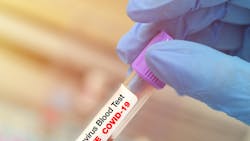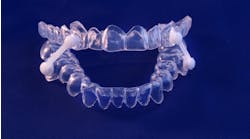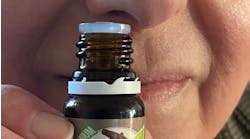COVID-19 testing in the dental office: How, when, and why?
As of May 31, 2020, the Centers for Disease Control and Prevention (CDC) reported a total of 1,761,503 cases of SARS-CoV-2 (COVID-19) in the United States. Of those cases, 103,700 people have died.1
One chart on the CDC website gives us a graphic to visualize COVID-19 cases by age1:
- Age 0–17: 54,921 cases
- Age 18–44: 560,226 cases
- Age 45–64: 485,373 cases
- Age 65–74: 143,545 cases
- Age 75+: 170,100 cases
These statistics show that the population group with the highest risk of contracting the virus is also the smallest segment. What does this mean for dental offices? Dental professionals need to be aware of the trends in viral contraction and identify their patients who have COVID-19 symptoms and/or those who may be asymptomatic but still carrying the virus.
Narrowing our view to health-care professionals, we find that there have been 66,447 cases of COVID-19 to date. Of those whose death status was available (37,485), 318 confirmed deaths have been reported.1
Several studies have suggested that mortality rates of COVID-19 are lower than many previously predicted.2 Screening patients for COVID-19 in the dental office should be routine. Certainly the outcome of testing would be helpful in determining how to provide further treatment of infected patients in a way that keeps uninfected patients healthy.
What do COVID-19 tests tell us?
Currently there are two types of tests for SARS-CoV-2: antibody tests and viral tests.3 Both of these tests are helpful; however, their results yield different findings because they test different things. Antibody tests can tell us if individuals have previously had an infection, since the body produces antibodies one to three weeks after contagion. Viral tests, on the other hand, can determine whether an infection currently exists.
Why is testing so important?
Our World in Data says it best: Without testing there is no data. Testing is our window onto the pandemic and how it is spreading.4 In areas without testing, the true number of COVID-19–infected individuals is likely to be much higher than the number of confirmed cases.
Scott Froum, DDS, editorial director of Perio-Implant Advisory, adds this:
“What the new CDC data shows is that a small segment of the overall population is the one with the greatest risk of disease severity and case fatality. If we can identify those patients who have greater risk, we could limit hospital visits. In addition to all the controls implemented in the dental office, your screening questions should ask about comorbidities associated with COVID-19. Those patients who fall into this category should be treated at times during the least office traffic.”
Dr. Froum created a COVID-19 patient screening checklist he uses in his office—a downloadable form with fillable fields. You can download the form at this link. This form should be used to screen each patient twice—once before the dental appointment and next during the in-office visit. Screenings at these two times will allow you to monitor any medical changes that may have occurred between checks.
Infection control in the dental office
With dental offices reopening, what is the infection control protocol you now use in your practice? Until a COVID-19 vaccine is developed and more information becomes available, you can rest in knowing that the infection control steps you employ for influenza can also help protect you and your patients from COVID-19.5 Further, by screening your patients as described above, you will be able to better protect all of your patients and contribute in a positive way toward the pandemic as a whole.
Sources for COVID-19:
- Latest infection control guidance from the CDC: cdc.gov/coronavirus/2019-ncov/hcp/infection-control.html
- Interpreting COVID-19 test results: whitehouse.gov/wp-content/uploads/2020/05/Testing-Guidance.pdf
- Latest research from the National Institutes of Health: nih.gov/health-information/coronavirus
- What to do before, during, and after patient visits: cdc.gov/coronavirus/2019-ncov/hcp/clinic-preparedness.html
Related reading:
- Vitamin D and COVID-19 disease severity: An old ally in a new war
- How one dentist in NYC is making his dental office a safe place post–COVID-19
- COVID-19 serology testing and the role of the dental office
- COVID-19 and the problem with aerosols
- A technique to improve the viral protection of a procedure mask in absence of an N95 shield respirator
References
- Coronavirus Disease 2019 (COVID-19). Cases in the US. Centers for Disease Control and Prevention. Updated May 31, 2020. https://www.cdc.gov/coronavirus/2019-ncov/cases-updates/cases-in-us.html
- Dutton G. Multiple studies suggest COVID-19 mortality rate may be lower than expected. BioSpace. May 7, 2020. Accessed June 1, 2020. https://www.biospace.com/article/multiple-studies-suggest-covid-19-mortality-rate-may-be-lower-than-expected-/
- Testing. Coronavirus Disease 2019 (COVID-19). Centers for Disease Control and Prevention. Updated April 28, 2020. https://www.cdc.gov/coronavirus/2019-ncov/testing/index.html
- Coronavirus (COVID-19) testing. Our World in Data. Updated May 30, 2020. https://ourworldindata.org/coronavirus-testing
- Get your clinic ready for Coronavirus Disease 2019 (COVID-19). Centers for Disease Control and Prevention. Updated March 11, 2020. https://www.cdc.gov/coronavirus/2019-ncov/hcp/clinic-preparedness.html








